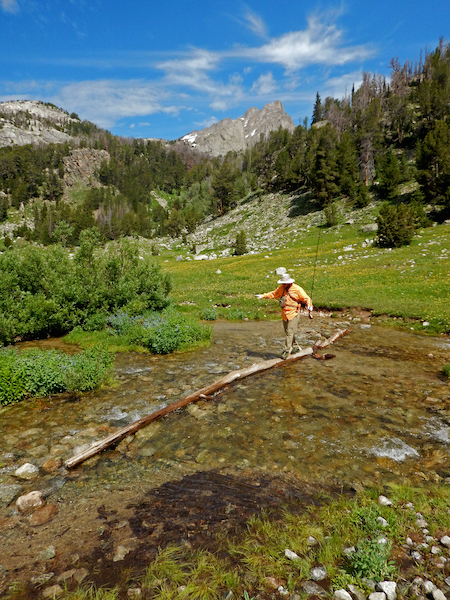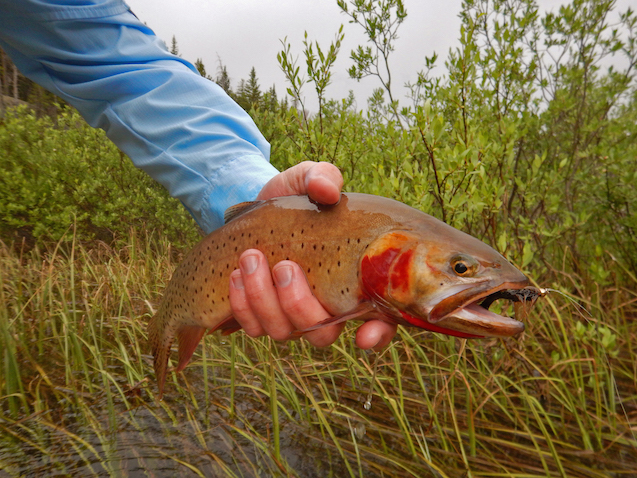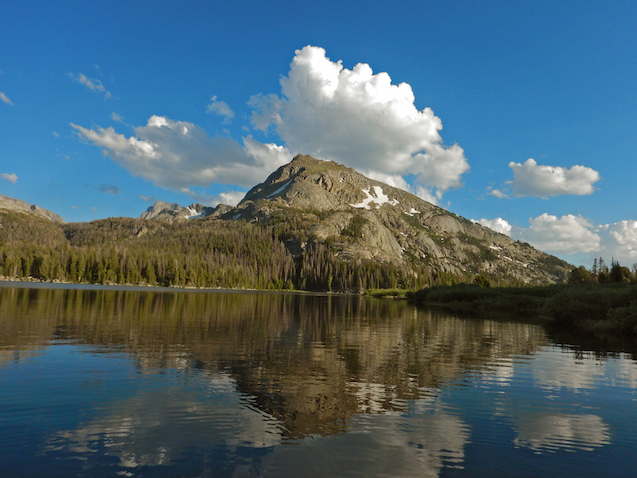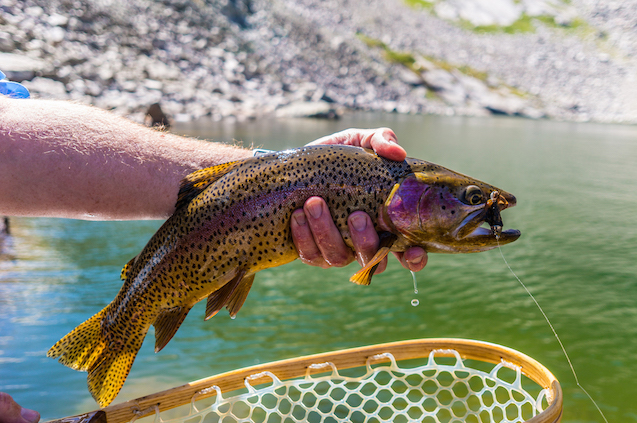We're thrilled to have Chadd VanZanten back in ESF. Join in as he fishes the Wind Rivers
It’s just before five o’clock on a morning in August at Big Sandy Lake. For an hour I’ve lain awake impatiently waiting as the tent fly displays the first rays of day. In the half-light I sit up and dress myself, head bumping the roof of the tent.
I unpackage myself from the tent like some great insect birthing from an egg sac, and then I sit in the frosted grass yawning, breath smoking. Everyone else is still asleep. The sun is not up but its light is touching the mountaintops on the west side of the valley.
 Everything is new to me. It’s all very interesting. Every glade, every waterfall, the backcountry spruce and pines arranged into copses that might have been groomed by some sentimental gardner. Even the ground is source of fascination to me, with its mosaic of miniature succulents, orange and purple lichen scales, jubilant forbs, and the salt-and-pepper speckled pebbles that crunch when stepped on. And the Wind River peaks loom over all, inscrutable brooding gods whose moods shift as sun and clouds move through.
Everything is new to me. It’s all very interesting. Every glade, every waterfall, the backcountry spruce and pines arranged into copses that might have been groomed by some sentimental gardner. Even the ground is source of fascination to me, with its mosaic of miniature succulents, orange and purple lichen scales, jubilant forbs, and the salt-and-pepper speckled pebbles that crunch when stepped on. And the Wind River peaks loom over all, inscrutable brooding gods whose moods shift as sun and clouds move through.
And then there is the lake waiting down in the floor of the valley, its misty surface a mirror to reflect the shades of imperceptibly gathering light. It is of course what schools in the lake that brings me here. It’s them I’ve come to see about. The mountains are astounding, without doubt, and the hillside thickets are darkly remarkable, too, but I have come here in search of water and I have come in search of trout.
My waders are stiff with cold. I push my feet down into the neoprene socks and pull them on as I stand up. My fly rod is already rigged and leaning against the branch of a bristlecone. I hastily eat a little breakfast.
Not long after I reach the lake, fish begin to rise, just a few at first, but as the sun comes up their feeding grows so frantic the lake dimples as though by invisible hailstones. Such exhibits of widespread, single-minded animal behavior are always affecting, but this is more rising fish than I’ have ever seen.
I tie on a Mosquito in size 16 or 18 and the trout slam it practically every time I cast. They strike whether the fly floats or sinks. They strike while it trails in the water as I wade. They hit so hard they miss the fly three times out of five. But I catch fish after fish. Soon the fly is sodden and slimy, then it begins to unravel, and after I unhook the eleventh or twelfth fish, it’s just a few wraps of frayed thread on an otherwise bare hook.
My first trip to the Wind Rivers has begun.
*
It’s late morning on a trail in the Wind Rivers, but this time on the eastern side of the Continental Divide. Early July. I’m backpacking with a group of six other people whom I don’t know well. I was invited by a guy I met while working at a fly shop. The hike is ten miles give or take, and our party has split into two factions--the fast hikers and the slower ones. No longer a rookie, I’m now the slowest member of the fast group. Five stream crossings lie across our route, requiring us to take off our hiking boots and shakily pick our way across the shifty, slippery rocks. The fast group fords the first crossing, then we pull our boots on. I make a weak attempt at starting a conversation, but this results in an awkward fizzle, so we just sit in the grass and swat at the jittery clouds of mosquitos as we watch for the others to bring up the rear. A cardinal rule of the Winds is that the fishing is good when the mosquitoes are bad, so I get out my fly rod, tie on a number 14 Elk Hair Caddis, and make a cast. The fly alights on the upwelling water at the foot of a fall. A small cutthroat seizes the fly with a carelessness that borders on contempt. I bring him in quick, unhitch him, and he swims off. I cast again to the same place and the same exact thing happens. After that I fish at each crossing, even if the wait is only a few minutes. At the second crossing I see the slow group approaching before I even get my rod set up, but I cast anyway and catch a fish. Over the course of the hike, I make eighteen or twenty casts and catch the same number of fish.
*
It’s nearing lunchtime, last day of a longer trip. A few of us have been fishing in the rain at a stream near our camp. Our jacket hoods are up and hats pulled low, but then the sun comes out, so I stop and lie in the grass by the bank to eat my lunch. Propped on one elbow I peek sleepily between the reeds and see a pod of fish feeding in the creek. They contend for position and take turns gulping the mayflies that glide down the drift like tiny sailing ships.
Dave’s son Braden joins me and watches the fish awhile. He’s maybe thirteen, a quiet kid. My fly rod is leaning on a rock somewhere behind me. Braden asks if he can try it.
“You fly fish?” I ask.
“I have a few times. I’m not very good yet.”
“Yeah, it’s tricky. Well, sure, grab that rod. Give it a try.”
He picks up the fly rod and unhooks the fly from the keeper. Then he goes to the grassy bank and waves the rod back and forth over his shoulder. The line flounces in the air, doubling back and whip-cracking.
“Lower your elbow,” I say without getting up. “Keep your wrist stiff.”
He doesn’t understand, but I don’t want to get off my ass to demonstrate. Eventually, he slings the line in the general direction the stream like a burst of Silly String. It lands in a heap on the water practically at his feet, then floats away dragging and sagging in the current.
Despite his best efforts, Braden catches a fish. It crashes up into the fly and pinwheels glittering over the water before splashing down again.
“I got one,” says Braden. It’s unclear if he’s pleased about this or not.
“Yeah,” I say. “Good job.”
I assume Braden’ll set the hook at some point that day, but there’s ten feet of slack line on the water between the fly and the top guide.
“Gotta set that hook,” I tell him through a mouthful of trailmix.
“Gotta do what now?”
“Pull back. On the rod. Lift the rod tip.”
It’s too late--the fish shakes the hook, but another one takes its place right away. And I don’t know if Braden notices, but this one is kind enough to set the hook itself, and then it begins a sort of one-sided struggle, like a dancer who commandeers the lead from a partner who doesn’t know the steps.

“You always have to set the hook in the fish’s mouth,” I explain. I pantomime a hook sticking me in the cheek. “Otherwise, he’ll just spit it out.”
The line has drifted downstream and straightened in the current. The replacement fish jumps and tail-walks, which strikes me as somewhat show-offy, but he stays hooked. Nice of him to be such a good sport. If fishing worked this way back in the real world, I think, everyone would own a fly rod and a tying vise.
Braden lifts the rod. It flexes with the weight of the fish and current, and Braden reels in. He meets the fish at the bank. A thirteen-inch rainbow, respectable for that stream. He unhooks the fish, lets it go. Then he rests my rod on the rock and walks away, apparently under the impression that, while fly fishing may be an easy way to catch trout, it’s too complicated to be very much fun.
*
It’s midday, mid August, mid stream. It’s sunny and warm with a few clouds scudding through, and I’ve skipped lunch with the others to fish by myself. Fly choice doesn’t seem to be important today. The fish are taking dries over fast water, so I launch a big Stimulator into the current, and the fly sinks in the jostle, but I see the bright yellow hackle a foot below the surface, and there comes the flicker of a striking fish. I set the hook and strip in a two-pound cuttbow. I get him into my net but I don’t lift him from the water. The fly falls out of his lip, and the fish swims against the side of the net. He’s got a battered, over-sized tail fin--probably a favorite of the local spawning females. With his bright, silvery flanks and fuschia throat, he glints in the sun like a jewelled sword. I push the net down into the water and out from under the fish, and he swims free. Then I wring the water from the Stimulator by pinching it in a fold of my shirtsleeve, but the Stimmie just won’t float anymore. I bite it off the tippet and stick it in my hat to dry. I open my flybox and wonder if there’s a fly in there that these fish won’t eat. I poke around and come up with Killer Caddis, just a size-8 nymph hook with five iridescent beads and a little crystal flash. No detail, no anatomy. My buddy Chip gave it to me while we were fishing for bluegill on Pelican Lake in the Uintah Basin. I shrug and tie it on and then cast it into the current. Nothing on the first try. Nothing on the second. On the third cast I feel a tug, and a minute or two later I net a fish. I reach down to jiggle out the hook, but before I let the current flush him from the net, I do a double-take. It’s the big-tailed cuttbow I just let go, the fish that bit the Stimmie.
*
It’s around 2:30 in the afternoon. Jason and I are halfway through a five-day trip on the Indian Reservation, where you buy a “Trespass Permit” instead of a Wyoming fishing license. We’re on a day hike to a cirque and a deep lake where I fished the year previously. Jason has seen the photos of the fish I caught on that trip, and so our fly rods flex and bob as we eagerly go. I’m leading the way; Jason follows.
On the way there we pass two other lakes on our left, and we see fish hunting in the shallows like German U-boats. They zig-zag and circle over light-colored mud among the submerged rocks.
“Look,” I say to Jason, pointing with my fly rod. “Look at that big boy.”
It’s a large cutthroat. From thirty yards I can plainly see his crimson gill plate and anvil-shaped head. He’s edging in toward the bank.
“Kinda far out there,” says Jason.
“Coming this way, though.”
I’m fishing with my tenkara rod, perfect for stealth-casting over shrubs to fish loitering near the shore or under overhanging banks, but it has a reach of only thirty feet. In my brain a frantic calculus gets underway, estimating the cutthroat’s rate of travel and approach angle to determine the point on the bank where I’ll need to be when he comes close enough for me to reach him.
I’m heading west on a game trail, about ten feet inland with the lake on my left. The cutthroat is also on a westering, with me on his right. As we converge, the chance of him spotting me goes up and up.
“He’s gonna see you, dude,” says Jason. He stops on the trail behind me.
“Maybe if I slow down he’ll pull ahead of me.”
“Maybe. I dunno. He’s getting away.”
“Shit. He’s really big.”
“Yeah, he’s big.”
“I know.”
That the cutthroat is big makes the situation quite a bit worse than if he were small. I cannot, must not lose this fish. To lose a fish like this to a blunder or bad technique will be a terrible blotch on my record. I go into a crouch and blunder through the chest-high shrubs, tripping and scrambling to stay with the cutthroat and line up a shot from behind him.
I lose sight of the fish. “Where’s he at?”
“Still there. By the rock. On the left.”
“That one?”
“Your other left. Don’t let him get away. See him?”
“Yeah. Shit. Shit.”
“He’s getting away, dude.”
As the cutthroat nears the bank, I stumble and I bark my shin on the stout knuckle of an alder trunk, maintaining just enough footing to continue forward with a kind of clawing, swimming motion. Jason stops kibitzing and now watches bemused as I thrash for open ground so I can start casting.
On my tippet is a size 10 Fat Albert to imitate the grasshoppers that crackle through the air like sparks of unharnessed electricity. They emerge on warm afternoons, advertising for sex by arcing up from the grass to snap and flash their red and yellow wings, a corps of miniscule semaphore signalmen.

The Fat Albert is a lumpy and crude imitation, more suggestive of a stepped-on Tootsie Roll than a sleek alpine ornithopter, but it is also a durable artificial, constructed mainly of foam that remains buoyant even after multiple maulings in the toothy mouths of mature trout.
The cutthroat still doesn’t see me. God alone knows why not. This fish must be quite distracted--family problems, pressure at work. It’s slightly unnerving. He’s within fifteen feet of the bank and I’m shadowing him, but he’s still moving forward and I need to gain another twelve feet if I want to cast far enough ahead of his nose for a nice, conspicuous take. I begin false-casting furiously, groping to find the line between getting spotted and getting into range. I move in.
And he turns around.
Something on the water’s surface has caught the cutthroat’s eye and he turns slowly for a better look. It’s a midge or spinner, invisible to me. The cutthroat takes it. He doesn’t swirl or jump for it, but I clearly hear a wet ploop as his beak breaks the surface and then closes for the eat.
Now the cutthroat is heading straight at me. I freeze, my limbs motionless in awkward attitudes. He swims past and I keep still, not even blinking, a land-lubber in a game of freeze-tag with a water ghost. He’s tall through the body, slight kype to his underbite, dark bronze back. Confident, predatory. He eats again from the surface, ploop, then angles off away from the shore in the direction he first came from.
All at once I’m behind him again, but I’ve got only one chance to cast before he’s out of range. A flurry of possibly relevant considerations occurs to me--wind direction, what’s in my backcast, if the yogurt in my fridge back home has maybe expired. I make one false cast and then lay the line down.

Photo courtesy of Klaus VanZanten
And it falls short.
The fly comes down slightly behind and off to one side of the cutthroat, but it comes down hard. Comes down like a cannonball. There’s a splash, radiating rings. The fish detects the commotion, circles back, and opens his mouth to take the fly. Good ole Fat Albert.
I pull back on the rod. The timing is perfect and will result in a very secure hook-set, probably in the cutthroat’s upper lip, where it’s bony and tough. The hook catches and the line traces up out of the water. The rod bends.
And the fly comes free.

There is a procession of poorly conjugated profanity. From me, I guess. It’s mostly just the word “shit” repeated over and over. I stuck the fish. The hook stuck him. It’s over. My eyes follow the fly and line sailing up from the water, and I know that when I look down again, I’ll see only a whorl of mud and an eddy in the shallows where the cutthroat had been.
I make a sloppy back cast, too low, almost snag the shrubs behind me, but when I look down, the cutthroat is still there. I gawk at him. Too big to have been bothered by the inconsequential prick of the hook, the cutthroat has come about again and is wondering where his meal went. He’s not spooked. He’s just annoyed.
My cast shoots forward and I somehow place the fly right back down on the disturbed water. It must seem to the fish as though Fat Albert never left the scene. The cutthroat opens wide. His pointed snout breaks the water, looms over the fly.
And I rip it away from him.
A sudden case of buck fever. Fat Albert rockets back through the water. The line and fly are airborne again. I get a glimpse of a turning tail, fins flattened to the body as the cutthroat flees. But when Fat Albert loops forward for his final cannonball, the cutthroat one-eightys around.

Photo courtesy of Klaus VanZanten
He’s four feet from the fly and pissed off. He pumps his tail for speed and hits Fat Albert like a train. When his jaws clamps on the fly, he turns on it fiercely, raising a semi-circular sheet of water with his tailfin.
It’s a beautiful take, a wild, violent take by a big, aggressive fish. When I play it back in my memory, it unfolds in slow motion, the fish bright, mouthparts radiant white, every water droplet a shard of sunlight.
I lift the rod. Upper jaw for sure. The line zings taut like a telegraph wire. It’s like setting the hook on a two-by-four. The cutthroat is hooked. He bolts.
And the rod shatters.
There is a drastic, glassy crack! and the tackle falls slack. I falter back. The line drifts down, rod tipping forward like a beaver-felled sapling into the water. A lower section of the rod has shivered into scores of impotent strips of graphite composite. It looks like Elmer Fudd’s shotgun after Bugs Bunny stuck his finger in it. My face isn’t covered in cartoon soot, but I’m as stunned as Fudd, eyes blinking.
When I regain my senses, I hear laughter. Jason comes up from behind, laughing his big booming laugh.
*
It’s the end of my first full day in the Wind Rivers. Big Sandy Valley blazes red and yellow in a fiery sundown. The evening planets and stars burn through the dusk, and all at once the place is a cosmic island of granite, floating, disconnected from the world. Down at the lake, the fish start to rise again just as my camp-mates begin breaking sticks of firewood with their knees. I head out to fish down by the outlet, where the water is shallow. I hop out onto a rock and cast. Sometimes I hook a trout and sometimes the trout get away, but they hit and hit. They are mindless, elemental, and there is no caution in them. Neither is there desire or sorrow. The fish want only one thing: to live. And so they feed and breed. Nothing else. They don’t speak, sleep, or dream. Each time I catch one, I’m reminded of how unlike them I am, how complicated and absorbed I am by the absurd abstractions of humankind--time, ownership, failure, belief. But with each fish I let go, I grow more aware that I am for now at least among them, and there are no cell towers or power lines above us, no pavement or sewer pipes below. All that lies between us and the center of the earth is twenty miles of bedrock and a sea of ageless molten iron, and there is nothing but a thin skin of vapor between this lake and the rest of the universe.
Read more from Chadd in his book "On Fishing The Northern Rockies"